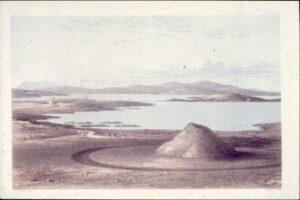
Recently, a team of specialists drawn from the Universities of Leicester and Southampton announced the find of a new structure within the south circle at Avebury. It is an exciting find that reminds us that these ancient and well-loved places still preserve their secrets. I found it particularly interesting because of the way in which the new formation, said to be composed of megaliths that were removed in the seventeenth and eighteenth centuries, comprises a square that is set within the heart of the surviving stone circle.
The team are, apparently, surprised to find a square megalithic setting, I can’t comment on that as my knowledge of megaliths around the UK is not, sadly, comprehensive, though I would point them to a paper published by Tim Darvill in the spring of 2016 which celebrates just this design at Stonehenge. I would also suggest that, were they to look north, they might find that the use of a square design, and indeed the overall design of a rectangle set within a circle is far from unusual. In fact, in Orkney, monuments comprising a square setting within a circle were all the rage among the special places of the late Neolithic. Perhaps the best known is Structure Eight at Barnhouse, where one is able to enter the reconstruction and experience for oneself how this type of architecture may have functioned. Another, well known example, is Structure Ten at Ness of Brodgar, only partly excavated but of similar design – contrast the angularity of the interior with the rounded nature of the exterior.
This internal angularity with external rounding is also seen in the house structure at Skara Brae, perhaps it is just how one did things in the Neolithic? But there is another site that suggests it may have a deeper meaning. Maeshowe is known for the circular platform on which it sits – yet the tomb interior is beautifully angular. Curiously, several archaeologists have suggested that there may have been a free standing rectangular stone setting on the platform at Maeshowe prior to the building of the tomb. And, of course, many of the stone-built chambered tombs of the north comprise rectangular chambers set within a rounded mound.
My guess is that were we to have a similarly detailed record of late Neolithic architecture right across the UK, we would find other uses of the square within the circle. Hopefully, the application of refined geophysics to sites away from the research heartlands of Wiltshire and Orkney will start to find them. What it actually meant is anyone’s guess, though I have noted before that it is still a powerful symbol (with many meanings) today. The new find at Avebury is indeed significant, but I’d caution against celebrating it as unique – to my mind it is more interesting if it starts to flesh out the nascent patterning of monumental settings that we are beginning to recognise across Neolithic Britain.
You must be logged in to post a comment.